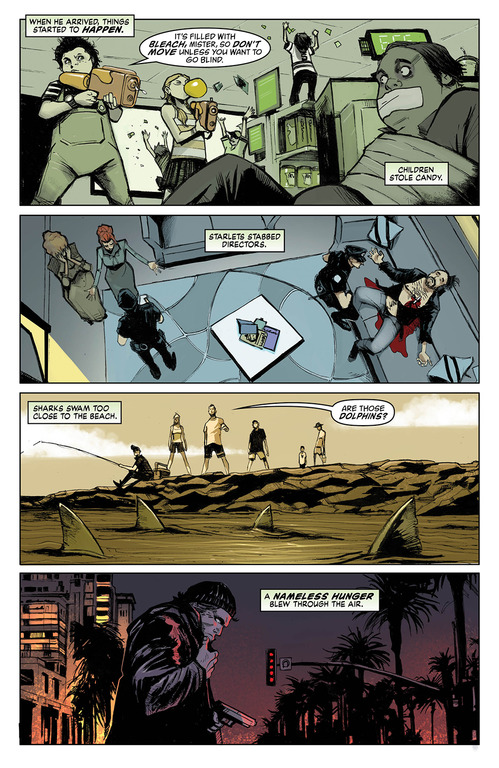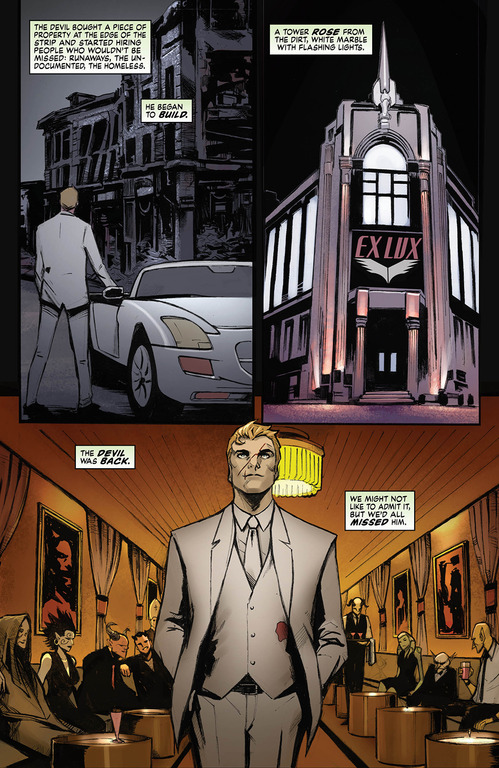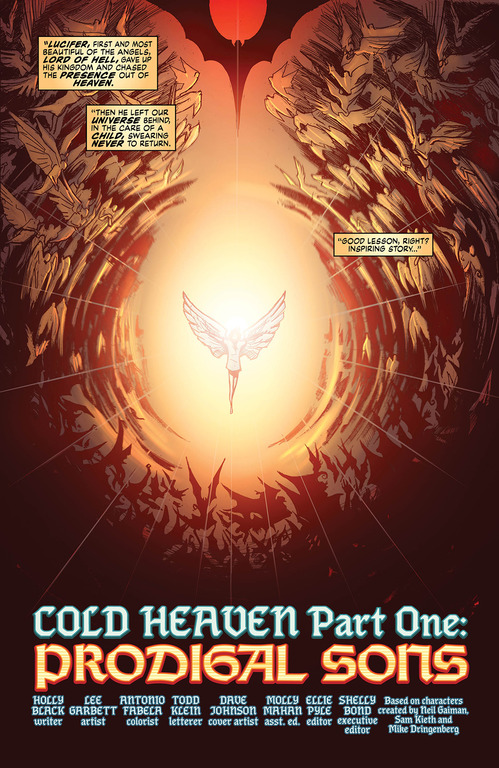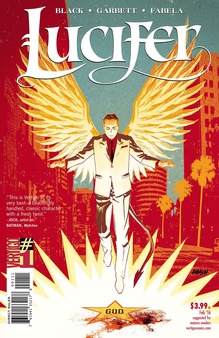“Stories About Heaven and Hell are Always Family Stories”: Holly Black, Lee Garbett Discuss Lucifer‘s Second Coming
Comics FeaturesSecond acts are rare to come by at Vertigo. The long-running and much-lauded mature readers imprint of DC Comics has staked a reputation, beginning with Neil Gaiman’s grand Sandman saga, on letting creators close the door on their beloved runs when the time seems right, sales potential be damned. While certain company-owned characters like Animal Man and the Doom Patrol lived long past their most celebrated creative teams (often with diminishing returns), properties like 100 Bullets and the aforementioned Sandman returned only when the original creators had a new tale to weave.
It was with trepidation, then, that many fans accepted the news of Lucifer returning to stands without Mike Carey and Peter Gross, the primary creators behind the 75-issue Sandman spin-off that took on a life of its own by chronicling the Morningstar’s quest to ponder the nature of free will. Carey and Gross, along with a talented host of guest artists, concluded Lucifer’s story quite succinctly in 2006. What is there left to say about the Adversary a decade later?
If novelist Holly Black (The Spiderwick Chronicles) and former Loki artist Lee Garbett’s first issue—out this Wednesday—is any indication, quite a bit. Picking up 10 years after Lucifer left Creation behind, Lucifer #1 sees the Lord of Lies accused of murdering his father (otherwise known as God). Gabriel, the fallen angel last seen in the pages of Hellblazer, has been given a shot at redemption if he can help the Host track down the murderer. Mazikeen, the former consort of Lucifer, sits atop the throne of Hell.
It’s been a hell of a decade.
In advance of the duo’s first issue, Paste spoke with Black and Garbett to discuss the shocking new status quo, the pressure of taking the reigns on a celebrated property and the surprisingly cheap cost of eternal souls. Vertigo has also shared exclusive preview pages from Lucifer #1. ![]()
Paste: Like a lot of fans of Mike Carey and Peter Gross’s Lucifer run, I was a bit nervous that a new series timed with the TV show might ignore what came before in favor of a streamlined take, but your first issue quickly obliterates that concern.
Holly Black: I really love [the original run]. I love it. And when I was first talking to Shelly [Bond, Vertigo executive editor], I had pitched her something a few years back and it hadn’t worked out, and she was like, “Remember that pitch we rejected?” And I was like, yes, I do remember that! [Laughs] “Maybe can do something else.” And I thought, oh, okay, maybe. I know my style, everything is straightforward, everything is fine, I know what I’m doing, and she said, “…or maybe you could write Lucifer.” And I was like, What?.
I love the book so much, I couldn’t say no. And then afterward I thought, What have I done? I love it so much, and now I’m completely intimidated. I understand why people are worried. Mike really tied that up tightly and it was a finished thing, and I just really hope people like it.
Lee Garbett: Holly did such a great job of bringing the character back without stepping on anything that came before. It just expands and flows right in. I’m looking forward to it coming out. It’s a natural progression and has a different feel, but the character that people love is there too.

Lucifer #1 Interior Art by Lee Garbett
Paste: Were the two of you fans of the run when it was first on shelves or was it something you came to more recently?
Garbett: I was definitely a fan.
Black: Oh yeah, from the time Lucifer was in The Sandman until the time he got his spin-off with Mike.
Garbett: It was hard to get hold of. We didn’t have a comic shop where I was, but we had a newsagent who would stock a bunch of DC books. I could get certain books, but Lucifer was always a hard one to track down. I got all the collected ones. But I’ve been a Vertigo fan from the get-go, really.
Paste: All the returning players from the previous run have major new status quos. Lucifer is back with an unhealing wound in his side, Gabriel from Hellblazer is in the mix, God is dead, and Mazikeen sits in her former lover’s throne in Hell, possibly against her will. How much time has passed since we last saw the Morningstar?
Black: About a decade. Otherwise, it would be confusing.
Paste: Gabriel’s inclusion is a bit of a surprise in that it’s the first real suggestion of a larger Vertigo “shared universe” since Hellblazer ended a few years ago. Was there any resistance to bringing that aspect of his backstory into play? Might we see other familiar faces from the wider Vertigo canon as the series goes on?
Black: We might. I would be excited to be able to. And no, when I proposed [including Gabriel], I wondered if they would let me do this, but indeed they did! [Laughs] We’ll see what they let us get away with.
Paste: Gabriel makes for two fallen angels in the book. How big of a role does he play in your larger story scheme?
Black: He gets to help investigate. They have a buddy cop situation going on for a little while. It’s fun to have somebody along for the ride. It’s fun to have them be able to talk to one another. I think stories about Heaven and Hell are always dynastic stories about kings and princes, and they’re always family stories about brothers and fathers, so when you’re talking about the murder of their father, it’s really useful to have these two siblings—who are many other things, but they’re also siblings—who are both estranged from their father.

Lucifer #1 Interior Art by Lee Garbett
Paste: Mike Carey famously avoided the other son of God in his story. Is that something you’ll tackle in your run?
Black: No. [Laughs] I think Mike was right about that.
Paste: Not unlike Morpheus in Sandman, Lucifer frequently receded into the background in Carey and Gross’s take to let other characters share the spotlight. Will we see interstitial issues like this in your run, or is there a tighter narrative focus on the Morningstar this time around?
Black: Actually, I just wrote an interstitial issue like that, which was really fun to do, where he’s sort of at the edges and implicit in the story. It was an opportunity to launch a different spanner in the works of the larger story.
Garbett: In the original run he would take a backseat and sort of watch from the background and stir the pot, but he definitely, especially in this arc, is more of a protagonist.
Paste: Lee, you’ve talked about what an honor it is to be working on a Vertigo title. Are there any past runs from the imprint that stand out as particularly inspiring to you as an artist, or influence your style on Lucifer?
Garbett: Definitely. I used to collect a lot of comics and I’d sort of fallen out of mainstream comics in the late ‘80s, early ‘90s I suppose, and then Vertigo came along. Death I think was one of the first things I saw, with Chris Bachalo, and his artwork was such a major influence on me and still is. He’s one of my art heroes. That run and Hellblazer as well, were books I collected from the get-go.
It’s funny, I think I’m coming into my tenth year [in comics] next year, and I always felt like Vertigo was where I’d end up, or aim for, really. And Karen Berger [long-time executive editor of Vertigo who stepped down in 2013]—I spoke to her quite a bit about different projects because it just seemed, in my mind, to be a natural fit.
Although I’m a big fan of superhero books, and I love working on those books as well, the Vertigo line did seem to be the most comfortable to me. So now it’s actually funny to be doing it ten years into [my career] and I’m proud to be part of it. I couldn’t believe it, to be on something like Lucifer as well.

Lucifer #1 Interior Art by Lee Garbett
Paste: Holly, while you’ve done graphic novels before, you’re best known for your prose. How did you first get involved with Vertigo?
Black: I actually did a project called A Flight of Angels with Rebecca Guay, the artist, and it’s a project she had wanted to do for a long time and couldn’t figure out a format for it. It’s almost an anthology of stories with a connecting story between them, but we didn’t know the connecting story when she was pitching it to Vertigo. [Laughs]
It was a couple years ago, and I was at Comic-Con because the movie for my much younger series was coming out and I was doing promotion there, so Rebecca dragged me up to meet with Shelly and pitch a connecting story that we didn’t have. Which I did! We actually ended up doing the project, and that was my first exposure.
Paste: As someone who works primarily in prose, what makes a story right for visual collaboration?
Black: I think there is a choice to make in the story and a lot of stories could be told either way. Obviously when you’re dealing with a lot of amazing visuals, they’ll lend themselves to a visual medium. I think stories that require a lack of interiority are actually better told in a visual medium. I wrote some con-man books a few years ago, and boy, writing a big con in a novel is really, really difficult, because you’re expected to have interiority, and you have to fake an enormous amount of things. Whereas big heists in films are really easy and really fun and pay off all the time.
I think for me, as a writer of mostly prose, the hardest thing is giving up the control. You’re used to being able to write, “They go into a forest. The forest is scary.” And then the forest is scary. But you’re writing them in a forest and you’re entirely trusting another person to establish the mood and do an enormous amount of characterization and you’re really putting half the story in someone else’s hands.
Garbett: I hadn’t thought of it like that, but that’s true, isn’t it? I’ve only ever written a little short thing for Vertigo that Jock did the art on, and even though that was a collaboration, I’d get pages back from that and it was completely different than I’d visualized it. It was great, but it was completely different. If you present 10 different artists with a script, they’ll come back with 10 different interpretations. I’m sure what I do is different from what you have in your mind, Holly. I try not to veer too far but it must be an odd thing to relinquish that control.
Black: It’s fun too!
Garbett: Even with color sometimes, you’ll get it back and be like, Oh, I never imagined it would be night in that shot. It’s not a problem that it’s night, it’s just a surprise because in your mind it was never that setting.

Lucifer #1 Interior Art by Lee Garbett
Paste: Holly, is it a challenge to adapt your creative process to a monthly medium? Does it change the way you write?
Black: Yes. I’m used to being able to finish a fairly long book and then hack it up from the beginning. I’m used to making a plan, honestly, and then being like, I don’t like my plan anymore. [Laughs] I rip it up entirely, and here I better really like my plan, and I better stand by the stuff I’m writing, because it’s going to exist in printed form and it’s going to be canon. So that’s new. [Laughs] Maybe the least appealing part!
Garbett: Holly’s working so far ahead. I’m not used to having the scripts done so far ahead of time, so I’m actually able to read them and see what’s coming up. A lot of time, I’ve had projects where I’ve worked “Marvel-style,” plot-based, and then the script comes afterward. Even then, you’ll get them sort of piecemeal. I think as Holly just said, she’s working on an issue from after this arc, and that’s been amazing.
Black: From a book publishing point of view, I’m so far behind. [Laughs]
Garbett: I’ve had scripts where it’s five pages every week, and I’m drawing them wondering how it’ll work out. I’m pretty quick as well, so from my perspective, this is pretty unbelievable.
Paste: Lee, Lucifer isn’t your first trickster deity ongoing. How has it been transitioning to Christian iconography after being absorbed in Asgardian lore? What sort of divine inspirations are informing your take on the devils and demons of L.A.?
Garbett: I was actually speaking to Vertigo about a different project. I had been out and I was checking my e-mails and there was one that asked if I could do some sketches to try out for Lucifer and I couldn’t believe it. I knew Loki was wrapping and I had some other things on offer, but it just felt like completely the right thing to do. Working on Loki probably helped that a little bit, I guess. It was in that kind of “bad-boy god” vibe, so it was a real natural progression.
The only downside was that I didn’t want to feel like I was repeating myself visually, so I’ve tried to make my style a little different for Lucifer. I always had a real creative vision for how I wanted him to be and look and carry himself. I’m using more pen and making it a bit scratchier than Loki, which was slicker perhaps. I’m trying to bring a bit of maturity to the art to fit the subject matter. And in terms of actually switching from Asgardians, I grew up reading comics and all of my Viking knowledge comes from reading Thor and all of my Gaul knowledge comes from reading Asterix, but I was raised going to Catholic school so I’m pretty well-versed in all that stuff as well. I know all the names. Oh, I know this guy. I’ve heard of this guy. [Laughs]

Lucifer #1 Interior Art by Lee Garbett
Paste: One of the most compelling aspects of Vertigo’s Lucifer is that he remains a morally compromised character even when he’s the protagonist. Is it challenging to keep that cruelty in the character and not over-sympathize with the Devil?
Black: I think that it’s complicated. Mike did such a great job of drawing you in and making you sympathize with him and then having him do something spectacularly cruel that would jolt you into remembering who he is. I think that’s what’s hard with him. You want to be able to both draw people in and undermine their expectations of him. You want them to fill in, “Oh he’s going to be fine, everything’s going to be fine,” then have him do something that reminds you, “Oh, he’s the devil.”
I think about that, but I also think of Lucifer in The Sandman, who was way more of a Pagan trickster figure. He was not quite as spectacularly cruel, but more changeable. So I remember that there is a spectrum of who he is and to think about him that way.
Paste: With that in mind, what sort of deal could Lucifer offer you that might be worth signing over your soul?
Black: If I could write faster? It’d be great if I could write better and faster. One-thousand percent, I’m signing right now.
Paste: You had that answer really ready to go.
Garbett: [Laughs]
Black: Weirdly, I was asked it in another interview, it’s not my fault!
Paste: I would do it for the cat demon butler from the first issue. That’s all it would take.
Garbett: That’s a good one, especially if he could draw as well. I would need to get him working. An office assistant for my eternal soul. An assistant would be enough.
